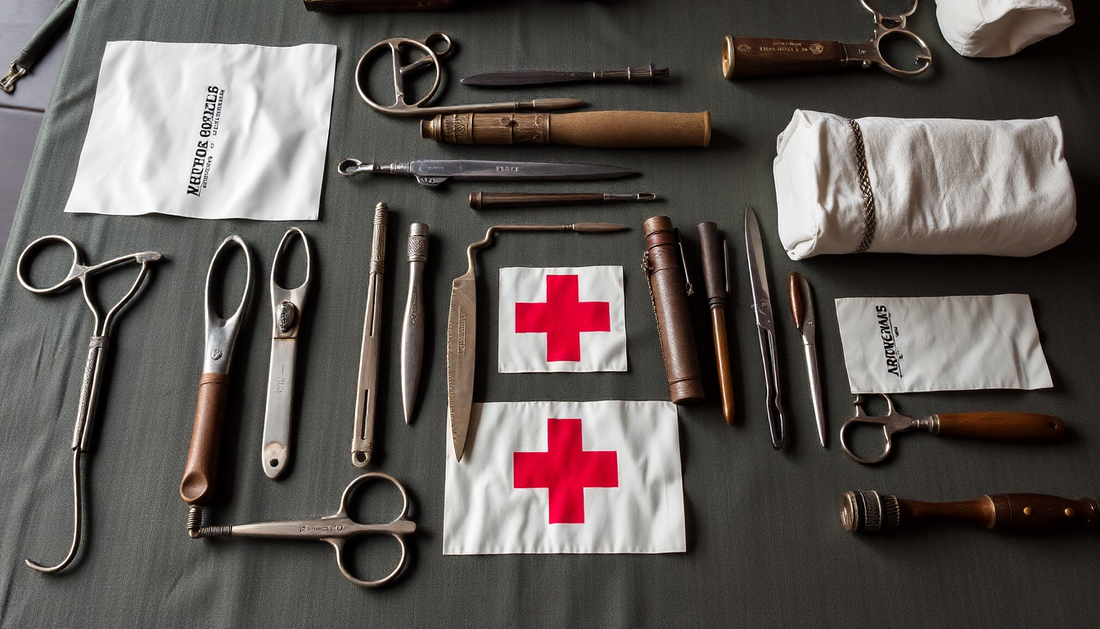
World War II Combat Medics' Equipment: A Complete Guide to Essential Tools
Share
Introduction
World War II, which lasted from 1939 to 1945, was one of the most devastating conflicts in human history. Beyond the battles and military strategies, an often overlooked aspect is the crucial role played by combat medics. These medical professionals risked their lives to save the lives of others, using essential medical tools to treat the wounded in extreme conditions. In this article, we will take an in-depth look at the equipment of World War II combat medics, highlighting the essential tools that made a difference on the battlefield.
The challenges of combat medics' work
Before exploring the specific equipment, it's important to understand the challenges combat medics faced. Often working under enemy fire and in dire circumstances, these medics had to demonstrate great resilience and adaptability. Field conditions were often rudimentary, with limited access to medical resources. Here are some of the main challenges:
- Limited access to medical supplies: Supply lines could be interrupted, making it difficult to obtain necessary supplies.
- Harsh environmental conditions: Doctors worked in varied environments, ranging from dense forests to arid deserts, often without proper shelter.
- Emotional stress: Witnessing suffering and death on a daily basis had a significant psychological impact on these professionals.
The essential tools of combat medics
Here is a list of the most commonly used equipment by combat medics during World War II:
- First Aid Kit: This kit included bandages, compresses, antiseptics, essential medicines, and other basic supplies to treat minor and major injuries.
- Stethoscope: Used to listen to the heartbeats and breathing sounds of wounded soldiers, this tool was essential for assessing the overall health of patients.
- Scalpel: A surgical tool crucial for making precise incisions during emergency operations. Its design allowed for great accuracy, which was essential under stressful conditions.
- Hemostatic forceps: These forceps were used to control bleeding by clamping blood vessels. They were especially useful in situations of severe trauma.
- Sterile Gloves: Essential for maintaining sterility during medical procedures, these gloves protected both the doctor and the patient from infection.
- Portable X-ray machine: This device allowed for the rapid diagnosis of fractures and internal injuries, providing a clear view of the condition of the injuries.
- Medical Truck: A vehicle specially designed to transport medics and medical supplies to the battlefield, enabling rapid response to emergency situations.
- Compression bandages: Used to control bleeding and stabilize injuries, they were an essential part of any medical intervention.
- Antiseptics: Products such as iodine and rubbing alcohol were used to clean wounds and prevent infection.
- Anesthesia machines: Although rudimentary by modern standards, these machines allowed surgical procedures to be performed with minimal pain for the patient.
Medical innovations of war
World War II was also a period of significant medical innovation. The urgent need to treat mass casualties led to advances that shaped modern medicine. Here are some of the most significant innovations:
- Antibiotics: The use of penicillin revolutionized the treatment of infections. Discovered by Alexander Fleming in 1928, penicillin was mass-produced during the war and saved countless lives.
- Blood transfusions: The development of blood banks saved many lives. Combat medics learned how to store and administer blood efficiently and safely.
- Triage techniques: These techniques were developed to quickly determine which soldiers required immediate care and which could wait, thus maximizing the chances of survival.
- War Surgery: Combat medics perfected specific surgical techniques to treat gunshot wounds and war injuries, paving the way for methods that are still used today.
- Medic Training: Training programs for combat medics have been intensified, incorporating combat simulations to prepare medics for the reality of the battlefield.
The Role of Combat Medics in War
Combat medics didn't just treat the wounded; they also played a vital role in troop morale. Their presence on the battlefield brought soldiers comfort, knowing that there was someone to care for them if they were injured. Their work included:
- Rapid Injury Assessment: Combat medics had to quickly assess the condition of soldiers and decide on the appropriate treatment.
- Pre-hospital care: Before soldiers were transported to more advanced medical facilities, they received immediate care on site.
- Soldier Education: Combat medics taught soldiers basic first aid techniques, enabling troops to assist each other in the event of injury.
- Epidemic Management: In unsanitary living conditions, combat medics also had to manage the prevention of infectious diseases, ensuring that troops remained healthy.
Conclusion
The combat medics of World War II were quiet heroes, armed with essential equipment and advanced medical skills. Their ability to save lives in difficult wartime conditions remains an inspiring example for medical professionals today. By understanding their equipment and role, we pay tribute to their dedication and expertise. War medicine has evolved thanks to their contributions, and their legacy lives on through modern medical practices.
